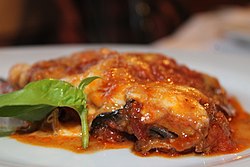Parmigiana
 | |
| Place of origin | Italy |
|---|---|
| Region or state | Southern Italy (Calabria, Campania, Apulia and Sicily) |
| Main ingredients | Eggplant,tomato sauce,Parmesan cheese,mozzarella,extra virgin olive oil,basil,salt |
Parmigiana(/ˌpɑːrmɪˈdʒɑːnə,-ˈʒɑː-/,Italian:[parmiˈdʒaːna]), also calledparmigiana di melanzane(Italian:[parmiˈdʒaːnadimelanˈdzaːne;-ˈtsaːne]),melanzane alla parmigiana(Italian:[melanˈdzaːne;-ˈtsaːneˌallaparmiˈdʒaːna]) or, in the United States,eggplant parmesan,is anItalian dishmade with fried, slicedeggplantlayered withcheeseandtomato sauce,then baked.[1][2][3][4]The origin of the dish is claimed by the southern regions ofCalabria,Campania,ApuliaandSicily.
History[edit]
There are several theories about the origin of the dish. Most frequently its invention is attributed to eitherParma,SicilyorCampania.[5][6]The case for Parma is that parmigiana refers to Parma and becauseParmesan cheeseis produced there. Sicilian food writers have several different explanations for a Sicilian origin. According to author Pino Correnti, the wordparmigianaderives from theSicilianword fordamigiana,a wicker sleeve used both for wine bottles and the hotcasserolein which the dish would be prepared and served. Authors Mary Taylor Simeti, Vincent Schiavelli, and several others write that the name derives from the Sicilian word for 'louver',palmigiana.The angled horizontal slats of a louver would resemble the layering of eggplant slices in the dish. Writer Franca Colonna Romano Apostolo suggests that the name isparmiciana,which means 'Persian' in Sicilian.[7][8]
Wright traces the origin of parmigiana toNaples.The ancestor of the modern dish appears inVincenzo Corrado's cookbookIl cuoco galantefrom 1786. His recipe described eggplant seasoned with butter, herbs, cinnamon, other spices and grated Parmesan cheese, which was then covered with a cream sauce of egg yolks before being baked in an oven. The modern version with Parmesan and tomato ragù as key ingredients appears several years later inIppolito Cavalcanti's cookbookCucina teorico-pratica,which was published in Naples in 1837. According to Wright, this suggests that the dish evolved in Naples during this time frame, which coincided with the increasing popularity of the tomato in Italian cuisine.[9][10]Author Marlena Spieler agrees with a Neapolitan origin of the dish for the same reasons.[11]
Preparation[edit]
The dish consists of sliced eggplant,pan friedin oil, layered with tomato sauce and cheese and baked in an oven.
In some versions, the sliced filling is first dipped in beaten eggs and dredged in flour or breadcrumbs before frying. Some recipes use hard grated cheeses, such asParmesan,while others use softer melting cheeses such asmozzarella,or a combination of these.
Italian variations[edit]
InCosenza,parmigiana is prepared with fried zucchini and baked eggplants. It is typically made in layers with grated freshmozzarellaand gratedParmesan.
InNaples,parmigiana is also prepared usingzucchiniorartichokesin place of eggplants.[12]
International variations[edit]
Variations made withbreadedmeatcutlets,such asvealandchicken,have been popularized in other countries, usually inareas of Italian immigration.In such areas, the original dish may be called "eggplant parmesan" to distinguish it from the meat versions.
In the United States and Canada,chicken parmesanand veal parmigiana are frequently served as amain course,often with a side ofpasta.The alternativeanglicizationParmesanis sometimes used instead, and the abbreviated formparmis common. The use of meats as an alternate to eggplant originated in the United States, where it was influenced by similar Italian dishes. A similar veal dish is known in Italian ascotoletta alla bolognese,which excludes tomato sauce but includes meltedParmesan cheeseandprosciutto.[13]Cotolette alla parmigianais another similar veal dish, but in Italy it is generally served without sauce or cheese.
Chicken parmigiana is also a common dish in Australia and is often served with a side of chips or salad. In Australia, where the name is often shortened toparma[14]orparmi,[15]it may also contain a variety of toppings, including sliced ham or bacon.[16]
In Argentina and in other neighboring South American countries, veal or chicken parmigiana is topped with ham and served with French fries. It is known asmilanesa a la napolitana.[17][18][19][20][21]If the dish is topped with a fried egg, it is known asmilanesa a caballo,but omits the tomato sauce.[22][23]
In England,parmouses either pork or chicken topped withbéchamel sauceinstead of tomato sauce.[24]
See also[edit]
![]() Media related toParmigianaat Wikimedia Commons
Media related toParmigianaat Wikimedia Commons
References[edit]
- ^"Eggplant Parmesan: The Traditional Recipe".La Cucina Italiana.Retrieved18 June2024.
- ^"Easy Eggplant Parmigiana".La Cucina Italiana.Retrieved18 June2024.
- ^"Parmigiana, Please: Not Just Eggplant!".La Cucina Italiana.Retrieved18 June2024.
- ^"Eggplant parmigiana".La Cucina del Tramonto d’Oro.Retrieved18 June2024.
- ^"The Eggplant Parmigiana: one dish, many versions - true-italian.com".2020-02-20. Archived fromthe originalon 2023-04-04.Retrieved2023-04-04.
- ^"What's the Deal With Eggplant Parmigiana?".La Cucina Italiana.Retrieved18 June2024.
- ^"Eggplant Parmesan, its History and Italian Origins".La Cucina Italiana.Retrieved18 June2024.
- ^Wright, Clifford A. (2012).Mediterranean Vegetables: A Cook's Compendium of All the Vegetables from the World's Healthiest Cuisine, with More Than 200 Recipes.Boston, Massachusetts: The Harvard Common Press. pp. 133–134.ISBN9781558327757.Archivedfrom the original on 2024-04-30.Retrieved2019-11-04.
- ^"Eggplant Parmesan, its History and Italian Origins".La Cucina Italiana.Retrieved18 June2024.
- ^Wright, Clifford A. (2012).Mediterranean Vegetables: A Cook's Compendium of All the Vegetables from the World's Healthiest Cuisine, with More Than 200 Recipes.Boston, Massachusetts: The Harvard Common Press. pp. 133–134.ISBN9781558327757.Archivedfrom the original on 2024-04-30.Retrieved2019-11-04.
- ^Spieler, Marlena (2018).A Taste of Naples: Neapolitan Culture, Cuisine, and Cooking.London: Rowman & Littlefield. pp. 189–191.ISBN9781442251267.Archivedfrom the original on 2024-04-30.Retrieved2019-11-04.
- ^Francesconi, Jeanne Caròla(1995) [1965].La vera cucina di Napoli(in Italian). Roma: Newton Compton Editori. pp. 219–20.ISBN8881830213.
- ^"Cotoletta alla bolognese"(in Italian). accademiaitalianadellacucina.it.Archivedfrom the original on 2019-07-03.Retrieved2020-04-13.
- ^"Archived copy"(PDF).Archived fromthe original(PDF)on 2017-02-14.Retrieved2017-05-24.
{{cite web}}:CS1 maint: archived copy as title (link) - ^Peucker, Christie (2011-01-02)."They're the parmi police Duo in quest for Adelaide's best".Sunday Mail.Adelaide, South Australia. p. 20. Archived fromthe originalon 2015-08-15.Retrieved2014-02-24.
- ^Levin, Darren (2004-08-07)."Keeping abreast of the Parma best".The Age.Melbourne, Victoria. p. A2.2.Archivedfrom the original on 2012-10-11.Retrieved2014-02-24.
- ^Pisarro, Marcelo (2012-05-11)."Milanesa napolitana".Clarín (Argentine newspaper)(in Spanish). Buenos Aires, Argentina. Archived fromthe originalon 2014-05-17.Retrieved2014-05-17.
- ^Pisarro, Marcelo (2012-05-11)."Milanesa napolitana".Clarín (Argentine newspaper)(in Spanish). Archived fromthe originalon 2014-05-17.Retrieved2014-05-17.
- ^"Milanesa a la napolitana".El Reporte(in Spanish). 2013-04-25.Archivedfrom the original on 2021-11-09.Retrieved2014-05-17.
- ^"El origen de la milanesa".ABC Color(in Spanish). 2013-04-13. Archived fromthe originalon 2014-05-17.
- ^Asier, Soren (2012-07-13)."Clásica milanesa napolitana de Argentina".iMujer(in Spanish). Archived fromthe originalon 2015-06-18.Retrieved2014-05-17.
- ^"Milanesa a caballo".tasteatlas.com.Archivedfrom the original on April 13, 2020.RetrievedApril 12,2020.
- ^"Milanesa 'on horseback' with french fries".bodegaargento.com.Archivedfrom the original on April 13, 2020.RetrievedApril 12,2020.
- ^"Teesside's fast food sensation".BBC.6 November 2011.Archivedfrom the original on 5 June 2016.Retrieved20 August2014.

